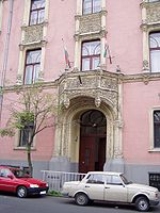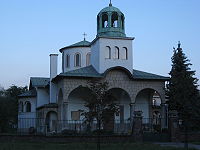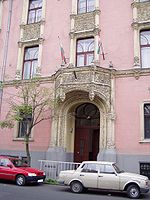
Bulgarians in Hungary
Encyclopedia


Bulgarians
Bulgarians
The Bulgarians are a South Slavic nation and ethnic group native to Bulgaria and neighbouring regions. Emigration has resulted in immigrant communities in a number of other countries.-History and ethnogenesis:...
are one of the thirteen officially recognized ethnic minorities in Hungary
Hungary
Hungary , officially the Republic of Hungary , is a landlocked country in Central Europe. It is situated in the Carpathian Basin and is bordered by Slovakia to the north, Ukraine and Romania to the east, Serbia and Croatia to the south, Slovenia to the southwest and Austria to the west. The...
since the Rights of National and Ethnic Minorities Act was enacted by the National Assembly of Hungary
National Assembly of Hungary
The National Assembly or Diet is the parliament of Hungary. The unicameral body consists of 386 members elected to 4-year terms. Election of members is based on a complex system involving both area and list election; parties must win at least 5% of the popular vote in order to enter list members...
on 7 July 1993. They number 2,316 and amount to 0.02% of the country's total population according to the 2001 census, but are estimated between 2,000 and 7,000 according to different authors.
In the Early Middle Ages
Early Middle Ages
The Early Middle Ages was the period of European history lasting from the 5th century to approximately 1000. The Early Middle Ages followed the decline of the Western Roman Empire and preceded the High Middle Ages...
, much of modern Hungary was often under the rule of the First Bulgarian Empire
First Bulgarian Empire
The First Bulgarian Empire was a medieval Bulgarian state founded in the north-eastern Balkans in c. 680 by the Bulgars, uniting with seven South Slavic tribes...
. The popular Bulgarian ruler Krum
Krum of Bulgaria
Krum the Horrible was Khan of Bulgaria, from after 796, but before 803, to 814 AD. During his reign the Bulgarian territory doubled in size, spreading from the middle Danube to the Dnieper and from Odrin to the Tatra Mountains. His able and energetic rule brought law and order to Bulgaria and...
may have been born in Pannonia
Pannonia
Pannonia was an ancient province of the Roman Empire bounded north and east by the Danube, coterminous westward with Noricum and upper Italy, and southward with Dalmatia and upper Moesia....
, and Bulgarian dukes like Salan
Salan
]Salan, Dux Salanus or Zalan was, according to the Gesta Hungarorum, a Bulgarian voivod who ruled in the 9th century between Danube and Tisa rivers, mainly in the territory of present-day Bačka region of Serbia and Hungary. The capital city of his voivodship was Titel...
, Glad
Glad (duke)
Glad was a duke of Bulgarian origin who, according to the 13th-century chronicle Gesta Ungarorum "", ruled in the territory of modern Banat at the time of the Hungarian conquest of the Carpathian Basin around 896...
, Ahtum
Ahtum
Ahtum, also Achtum or Ajtony , was a local ruler in the region of Banat in the first decades of the 11th century. King Saint Stephen I of Hungary sent Csanád - one of Ahtum’s former retainers - to fight against him...
, Sermon
Sermon (ruler)
Sermon was an 11th century voivode of Syrmia and a local governor in the First Bulgarian Empire, vassal of Bulgarian emperor Samuil...
and Menumorut
Menumorut
For the residential district named after him, see Menumorut, Satu MareMenumorut or Menumorout ruled, according to the 13th century Gesta Ungarorum , the land between the rivers Tisa, Mureş and Someş when the Magyars invaded the Carpathian Basin around 895...
are mentioned as the lords of Syrmia
Syrmia
Syrmia is a fertile region of the Pannonian Plain in Europe, between the Danube and Sava rivers. It is divided between Serbia in the east and Croatia in the west....
, Banat
Banat
The Banat is a geographical and historical region in Central Europe currently divided between three countries: the eastern part lies in western Romania , the western part in northeastern Serbia , and a small...
, Bačka
Backa
Bačka is a geographical area within the Pannonian plain bordered by the river Danube to the west and south, and by the river Tisza to the east of which confluence is located near Titel...
and parts of Transylvania
Transylvania
Transylvania is a historical region in the central part of Romania. Bounded on the east and south by the Carpathian mountain range, historical Transylvania extended in the west to the Apuseni Mountains; however, the term sometimes encompasses not only Transylvania proper, but also the historical...
proper in the 9th-11th centuries according to the Gesta Hungarorum
Gesta Hungarorum
Gesta Hungarorum is a record of early Hungarian history by an unknown author who describes himself as Anonymi Bele Regis Notarii , but is generally cited as Anonymus...
.
The northern Hungarian town of Szentendre
Szentendre
Szentendre is a riverside town in Pest county, Hungary, near the capital city Budapest. It is known for its museums , galleries, and artists. Due to its picturesque appearance and easy rail and river access, it has become a popular destination for tourists staying in Budapest...
and the surrounding villages were inhabited by Bulgarians since the Middle Ages
Middle Ages
The Middle Ages is a periodization of European history from the 5th century to the 15th century. The Middle Ages follows the fall of the Western Roman Empire in 476 and precedes the Early Modern Era. It is the middle period of a three-period division of Western history: Classic, Medieval and Modern...
. In the 18th century, Szentendre had a Bulgarian neighbourhood of settlers from Chiprovtsi
Chiprovtsi
Chiprovtsi is a small town and municipality in northwestern Bulgaria, administratively part of Montana Province. It lies on the shores of the river Ogosta in the western Balkan Mountains, very close to the Bulgarian-Serbian border...
and a "Chiprovtsi church", indicating refugees from the time of the Chiprovtsi Uprising
Chiprovtsi Uprising
The Chiprovtsi Uprising was an uprising against Ottoman rule organized in northwestern Bulgaria by Roman Catholic Bulgarians, but also involving many Eastern Orthodox Christians...
. A village near Visegrád
Visegrád
Visegrád is a small castle town in Pest County, Hungary.Situated north of Budapest on the right bank of the Danube in the Danube Bend, Visegrád has a population 1,654 as of 2001...
was called Bolgár falu ("Bulgarian village") in the 16th century; Bulgarian refugees fleeing the Ottoman
Ottoman Empire
The Ottoman EmpireIt was usually referred to as the "Ottoman Empire", the "Turkish Empire", the "Ottoman Caliphate" or more commonly "Turkey" by its contemporaries...
rule are first mentioned as inhabitants of this area on 30 December 1428. Gradually, however, these Bulgarians were assimilated into the Magyar population.
A number of Roman Catholic
Roman Catholicism in Bulgaria
Roman Catholicism is the third largest religious congregation in Bulgaria, after Eastern Orthodoxy and Islam. It has roots in the country since the Middle Ages and is part of the worldwide Roman Catholic Church, under the spiritual leadership of the Pope and curia in Rome.As an entity, the Catholic...
Banat Bulgarians
Banat Bulgarians
The Banat Bulgarians are a distinct Bulgarian minority group which settled in the 18th century in the region of the Banat, which was then ruled by the Habsburgs and after World War I was divided between Romania, Serbia, and Hungary...
settled in what is today Hungary as a secondary migration, establishing an early and small Banat Bulgarian community in Hungary. In Bulgarian interwar publications, their number is rounded and possibly overestimated at 10,000.
However, the Bulgarian ethnic community is largely descended from gardeners and other professionals who migrated to Austria-Hungary
Austria-Hungary
Austria-Hungary , more formally known as the Kingdoms and Lands Represented in the Imperial Council and the Lands of the Holy Hungarian Crown of Saint Stephen, was a constitutional monarchic union between the crowns of the Austrian Empire and the Kingdom of Hungary in...
in large groups in the 18th, 19th and 20th centuries, prior to World War I
World War I
World War I , which was predominantly called the World War or the Great War from its occurrence until 1939, and the First World War or World War I thereafter, was a major war centred in Europe that began on 28 July 1914 and lasted until 11 November 1918...
. In 1857, Bulgarians in Pest-Pilis-Solt-Kiskun
Pest-Pilis-Solt-Kiskun
Pest-Pilis-Solt-Kiskun is the name of a historic administrative county of the Kingdom of Hungary. Its territory is presently in central Hungary, comprising the territory of the present Hungarian county Pest and the northern part of present Bács-Kiskun county...
(not counting Pest
Pest (city)
Pest is the eastern, mostly flat part of Budapest, Hungary, comprising about two thirds of the city's territory. It is divided from Buda, the other part of Budapest, by the Danube River. Among its most notable parts are the Inner City, including the Hungarian Parliament, Heroes' Square and...
, Buda
Buda
For detailed information see: History of Buda CastleBuda is the western part of the Hungarian capital Budapest on the west bank of the Danube. The name Buda takes its name from the name of Bleda the Hun ruler, whose name is also Buda in Hungarian.Buda comprises about one-third of Budapest's...
and Kecskemét
Kecskemét
Kecskemét is a city in the central part of Hungary. It is the 8th largest city of the country, and the county seat of Bács-Kiskun.Kecskemét lies halfway between the capital Budapest and the country's third-largest city, Szeged, 86 kilometres from both of them and almost equal distance from the two...
) numbered 2,815, and their population had not changed significantly in 1870.
The oldest Bulgarian organization in Hungary, the Association of Bulgarians in Hungary, was founded in 1914 on the initiative of Lazar Ivanov from Teteven
Teteven
Teteven is a town on the banks of the Vit river, at the foot of Stara Planina mountain in north central Bulgaria. It is the administrative centre of the homonymous Teteven Municipality which is a part of Lovech Province. As of December 2009, the town has a population of 10,613 inhabitants.The town...
. The Bulgarian Church Community was founded in 1916 and the first Bulgarian school in 1918. Since then, the Bulgarian community has diversified to a great extent.
The Bulgarian Orthodox
Bulgarian Orthodox Church
The Bulgarian Orthodox Church - Bulgarian Patriarchate is an autocephalous Eastern Orthodox Church with some 6.5 million members in the Republic of Bulgaria and between 1.5 and 2.0 million members in a number of European countries, the Americas and Australia...
church of Ss. Cyril and Methodius in Ferencváros
Ferencváros
Ferencváros is the 9th district of Budapest , Hungary.- Name :The southern suburb of Pest was named after King Francis I on 4 December 1792 when he was crowned king of Hungary.- History :The development of Ferencváros began in the late 18th century....
, Budapest
Budapest
Budapest is the capital of Hungary. As the largest city of Hungary, it is the country's principal political, cultural, commercial, industrial, and transportation centre. In 2011, Budapest had 1,733,685 inhabitants, down from its 1989 peak of 2,113,645 due to suburbanization. The Budapest Commuter...
was constructed in 1932. A Bulgarian newspaper, Balgarski vesti, and a Bulgarian magazine, Hemus, are published by the Bulgarian community, as well as various books. There exist a number of folk dance groups, a theatre, several orchestras, a Bulgarian school for the native language and a Bulgarian-Hungarian secondary school for languages named after Hristo Botev
Hristo Botev
Hristo Botev , born Hristo Botyov Petkov , was a Bulgarian poet and national revolutionary. Botev is widely considered by Bulgarians to be a symbolic historical figure and national hero.-Early years:...
.

